
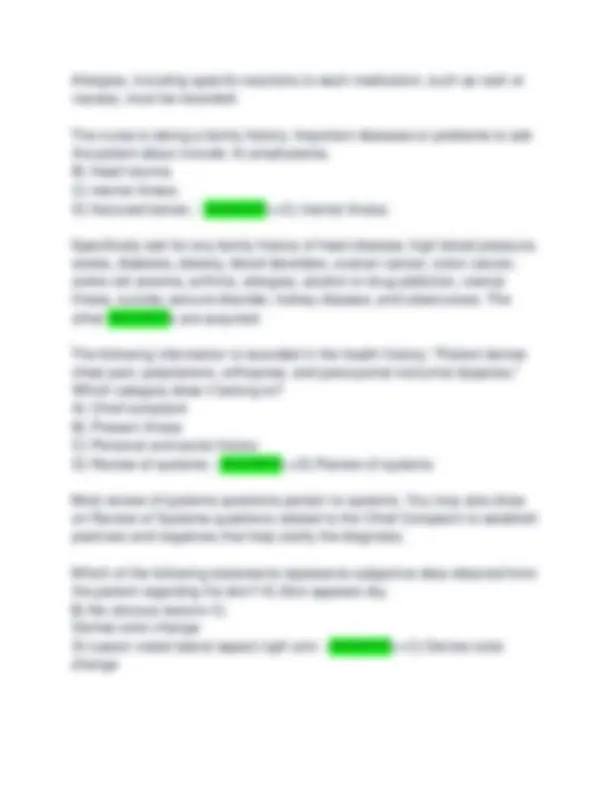
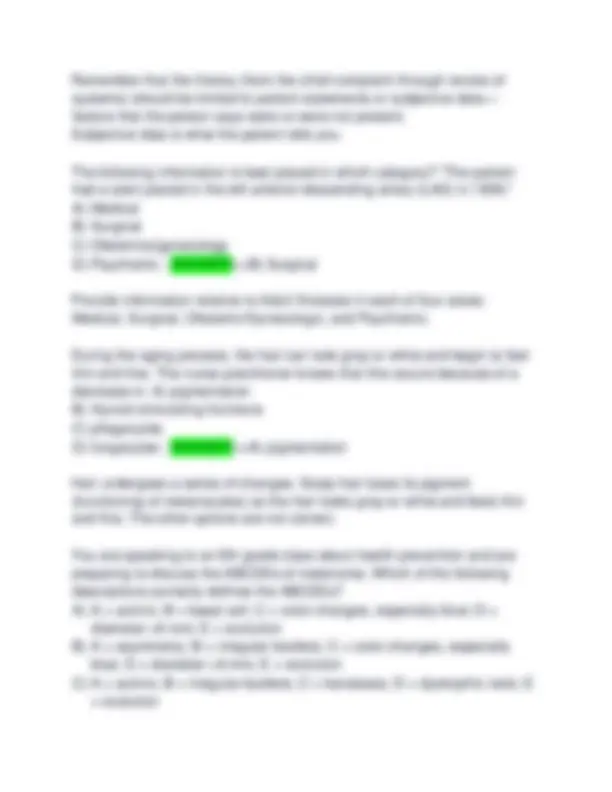
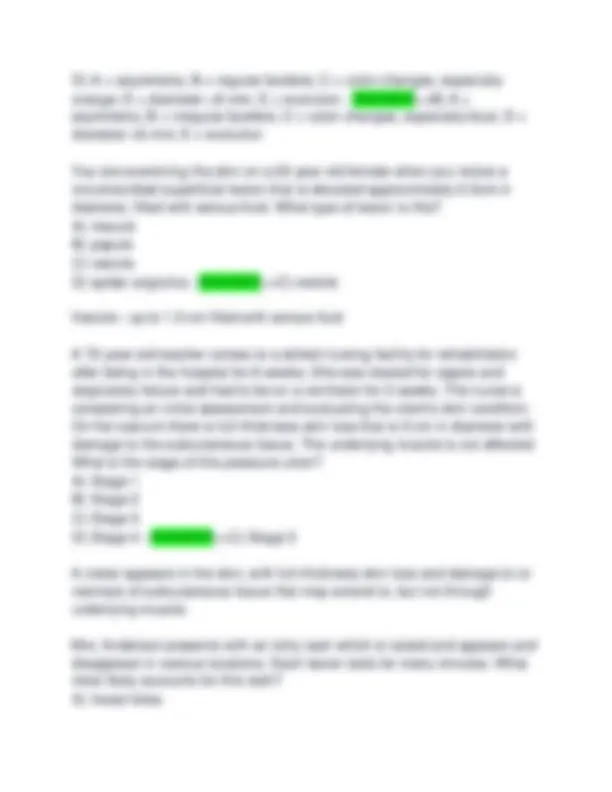
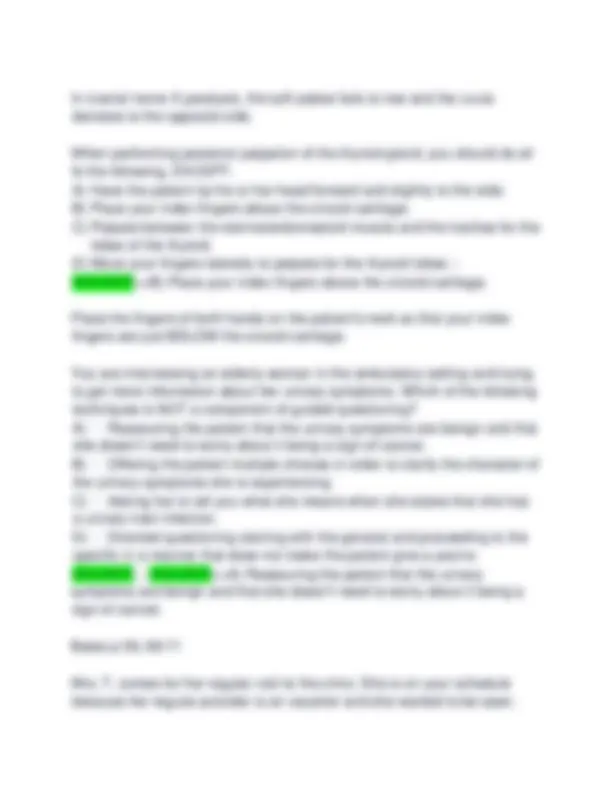
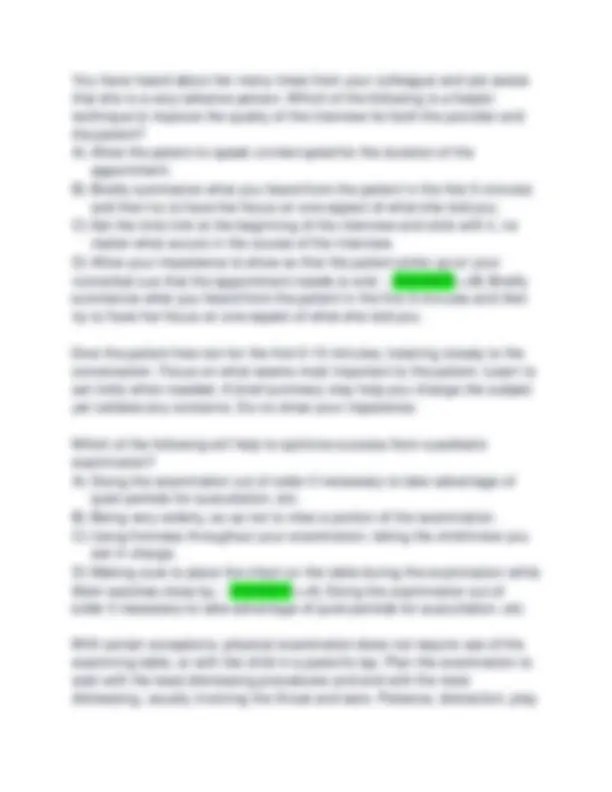
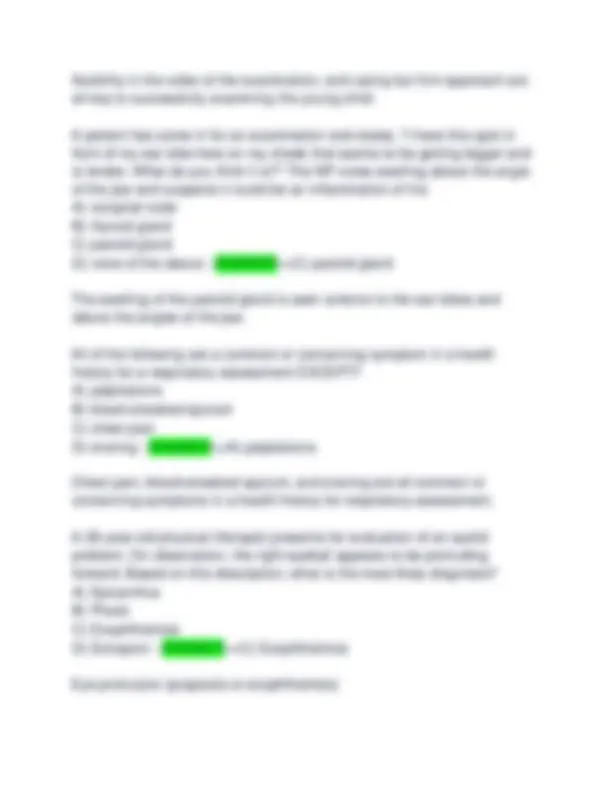
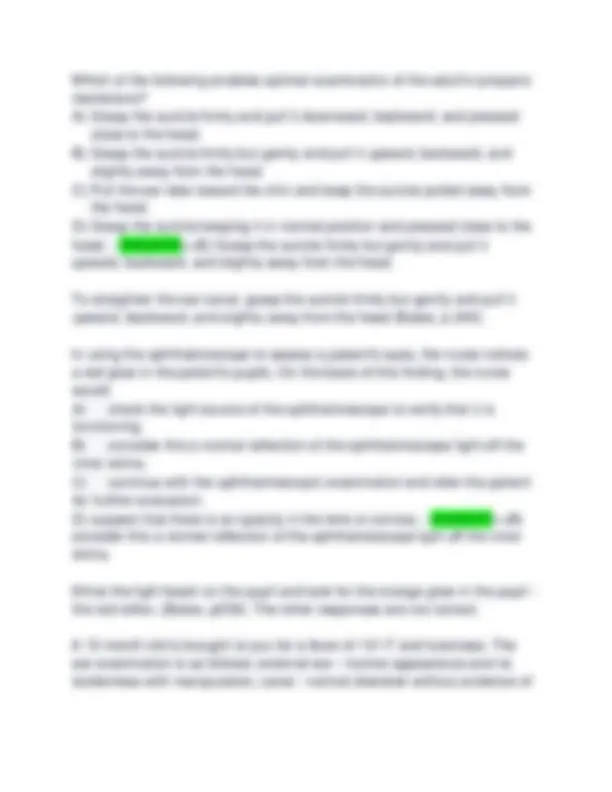
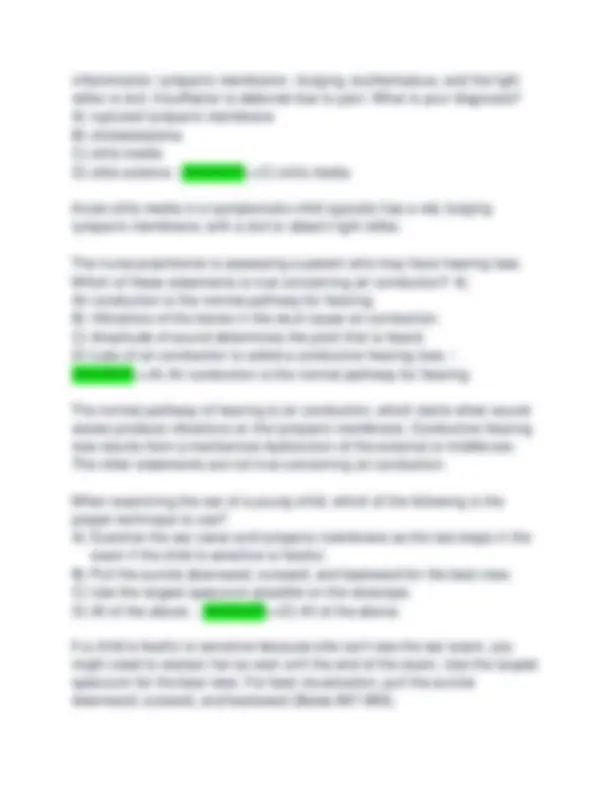
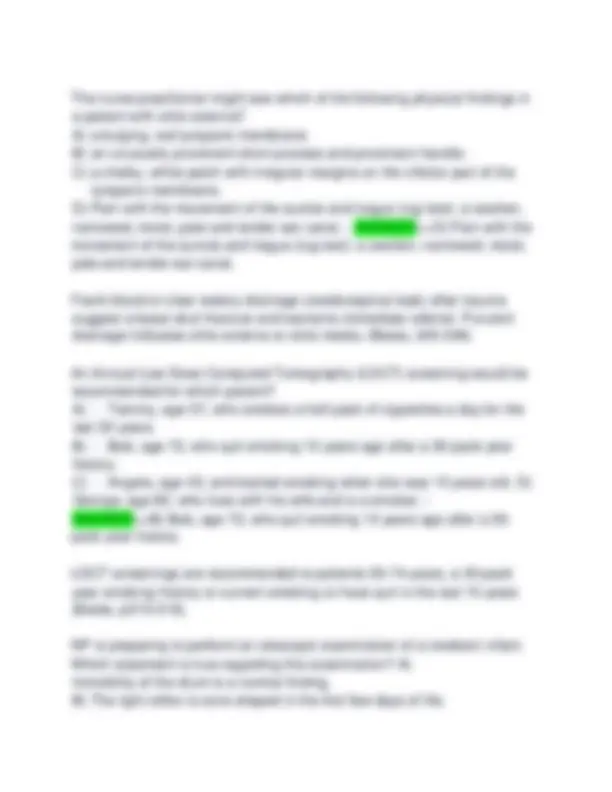
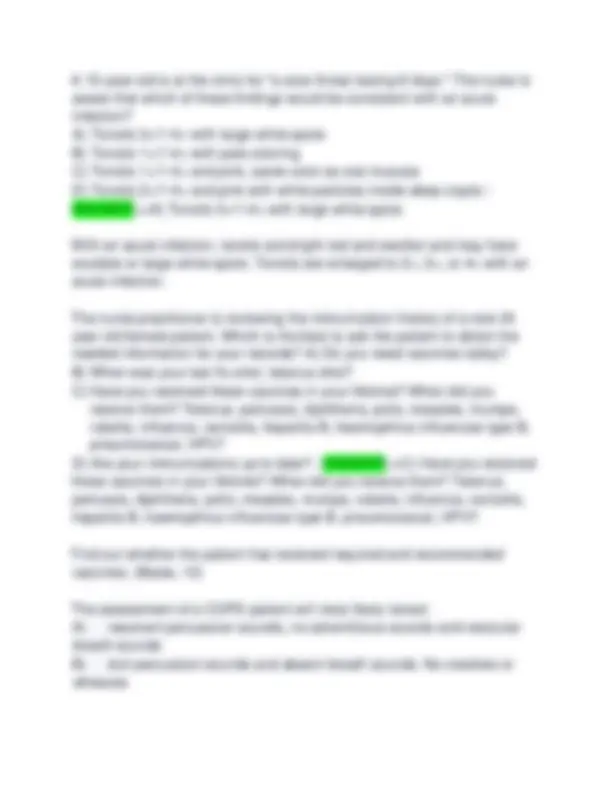
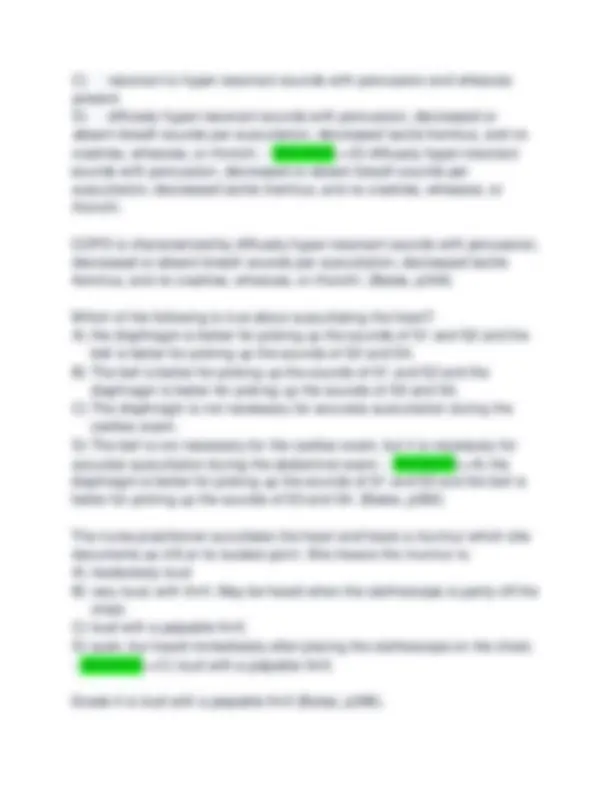
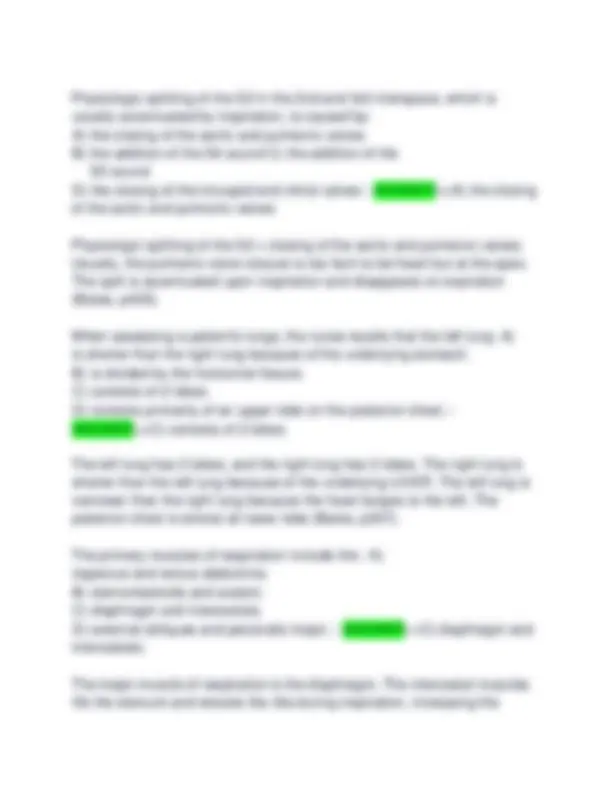
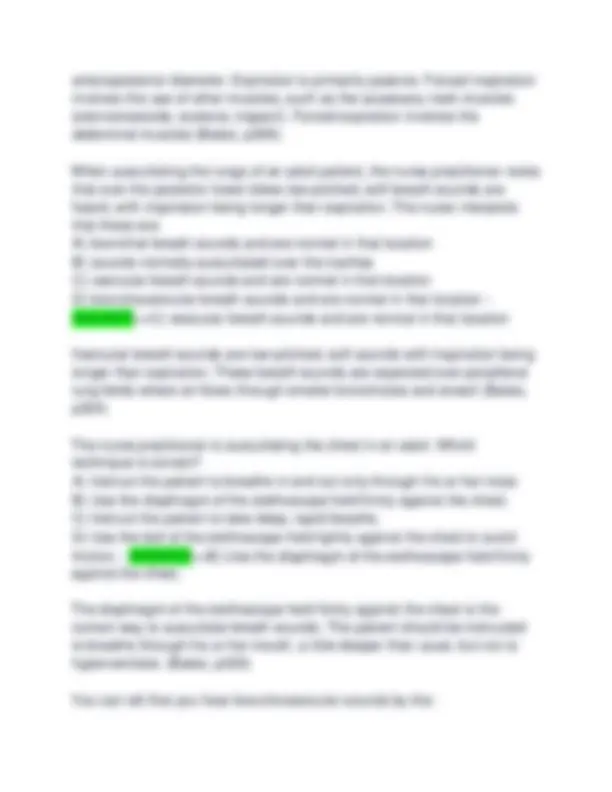
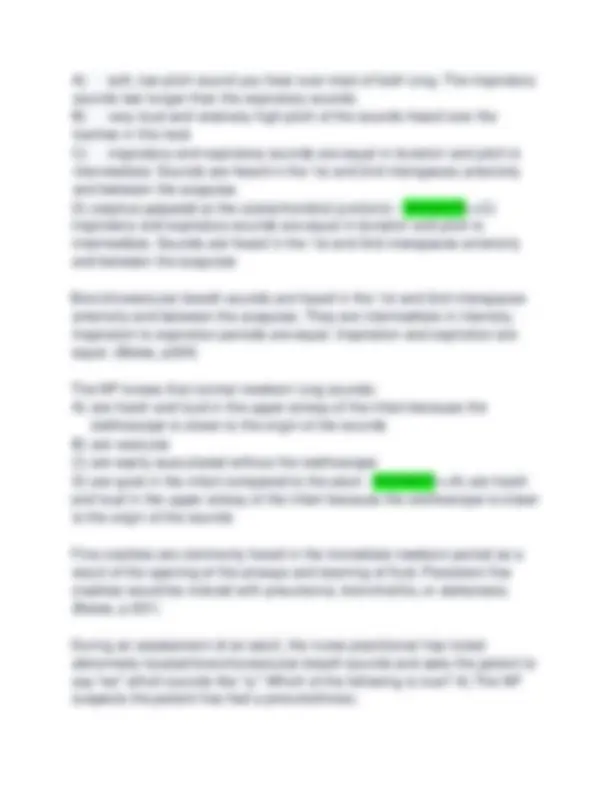
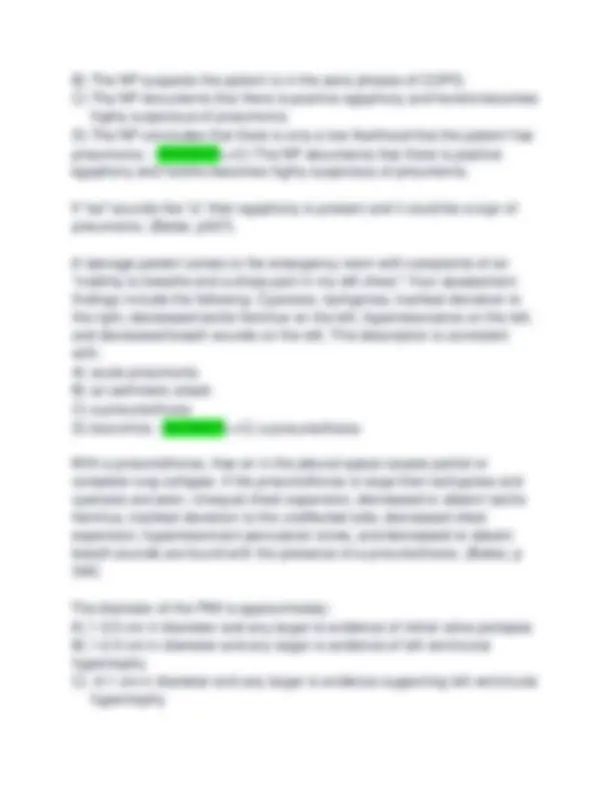
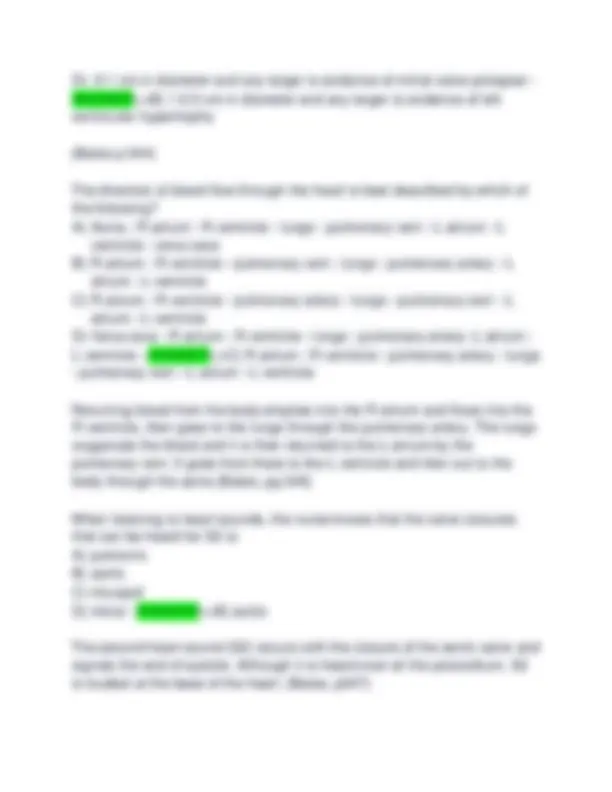
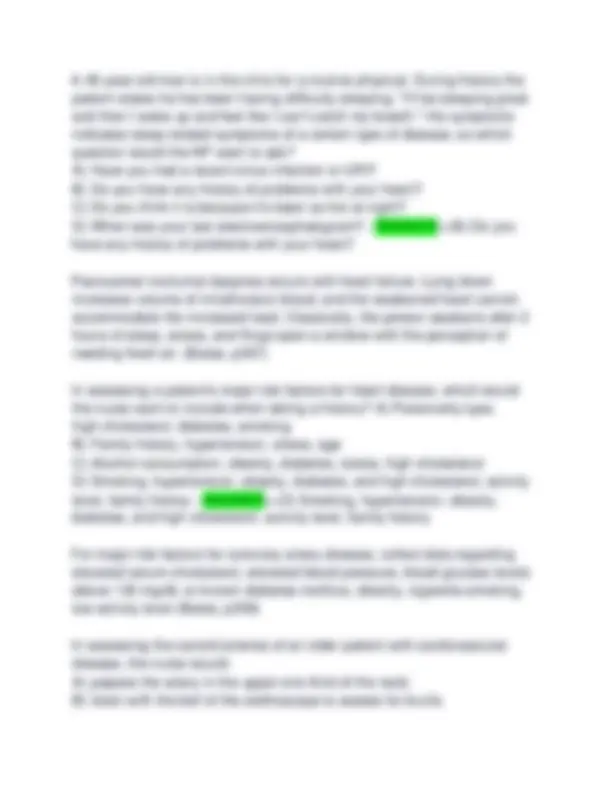
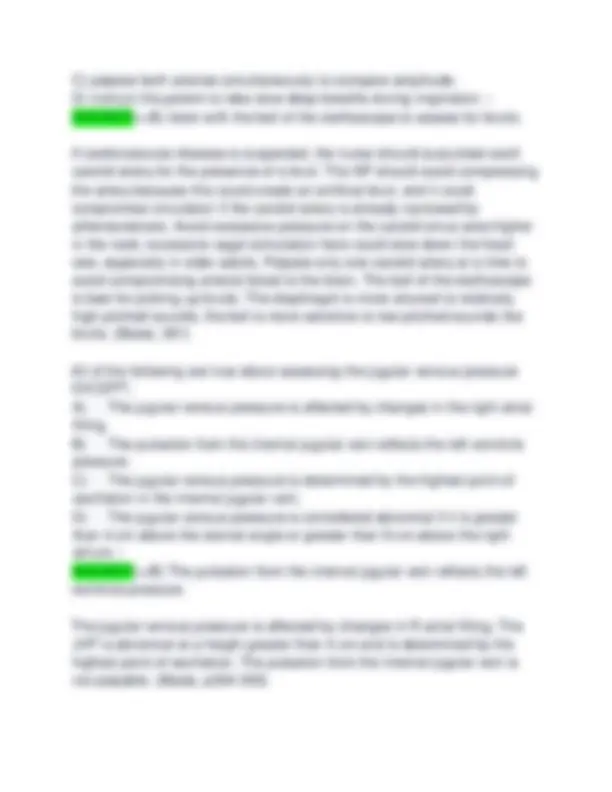
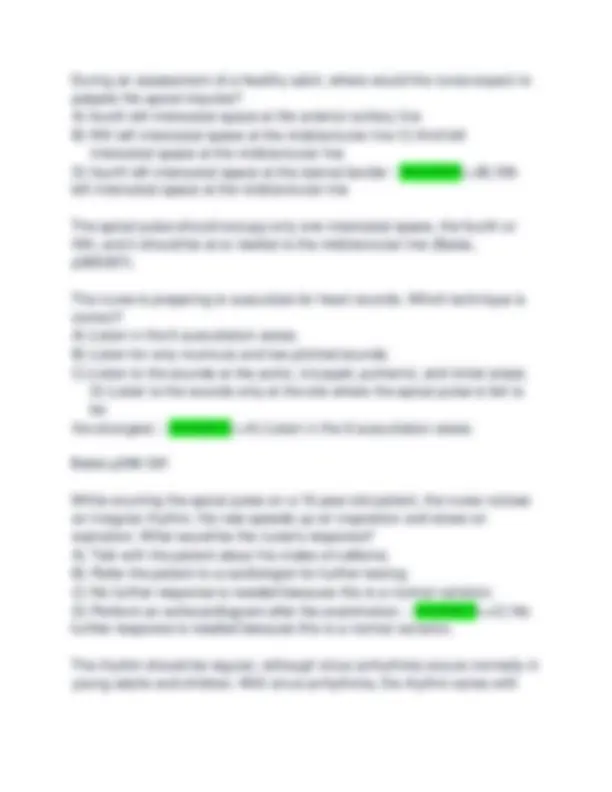
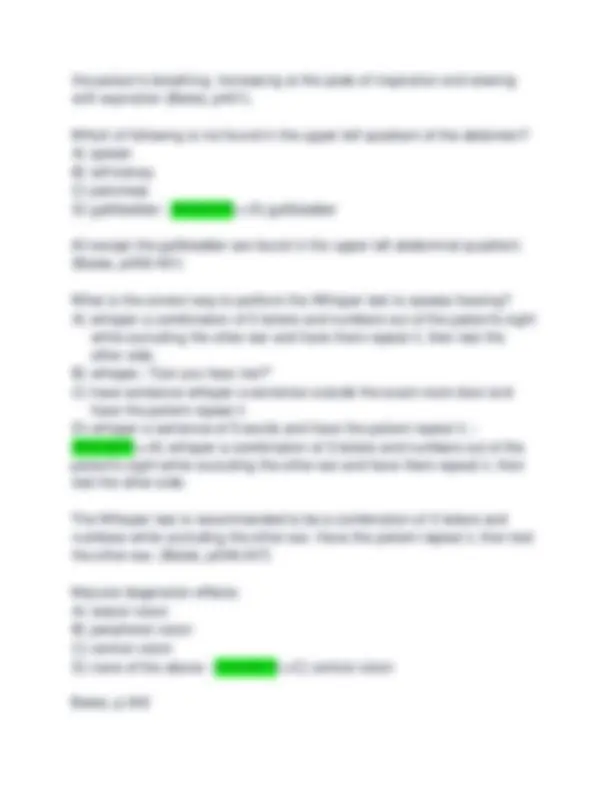
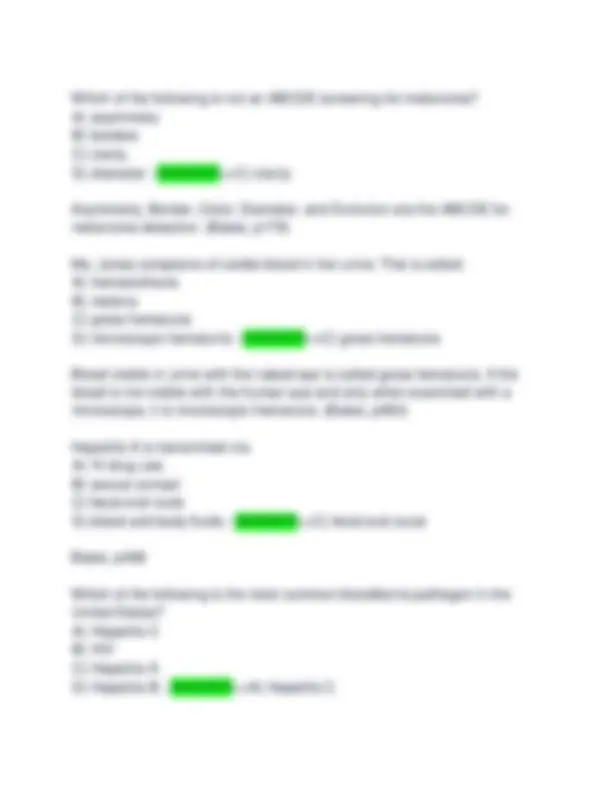
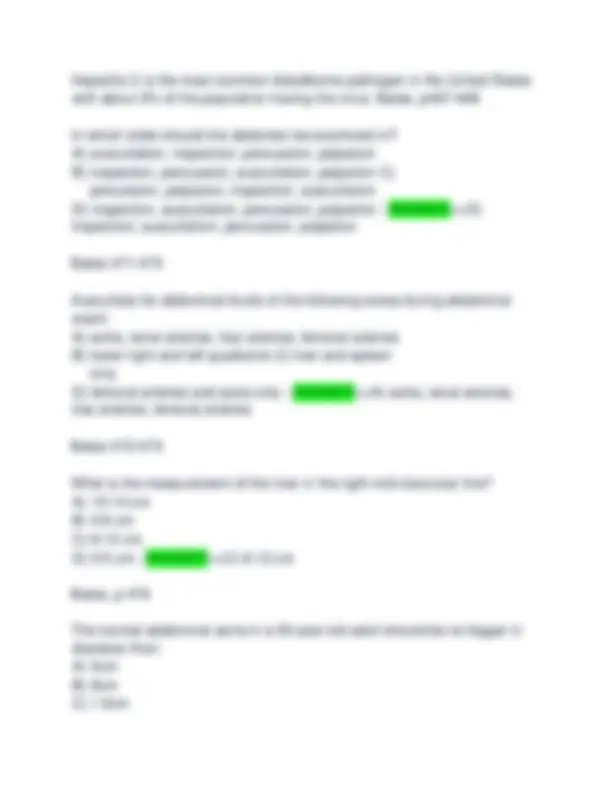
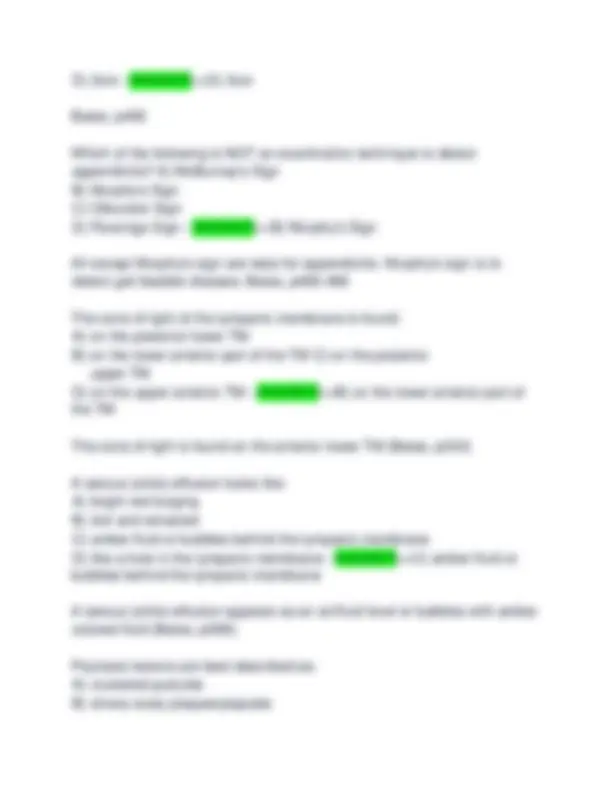
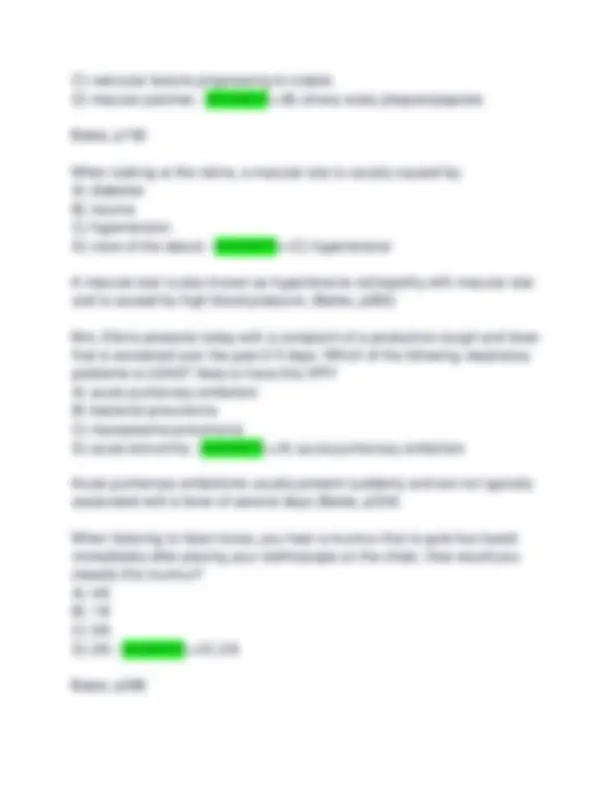
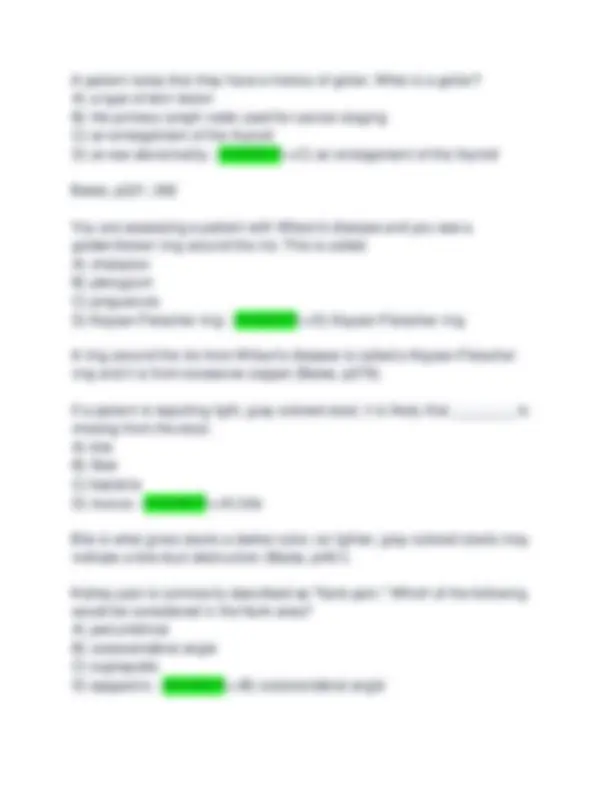
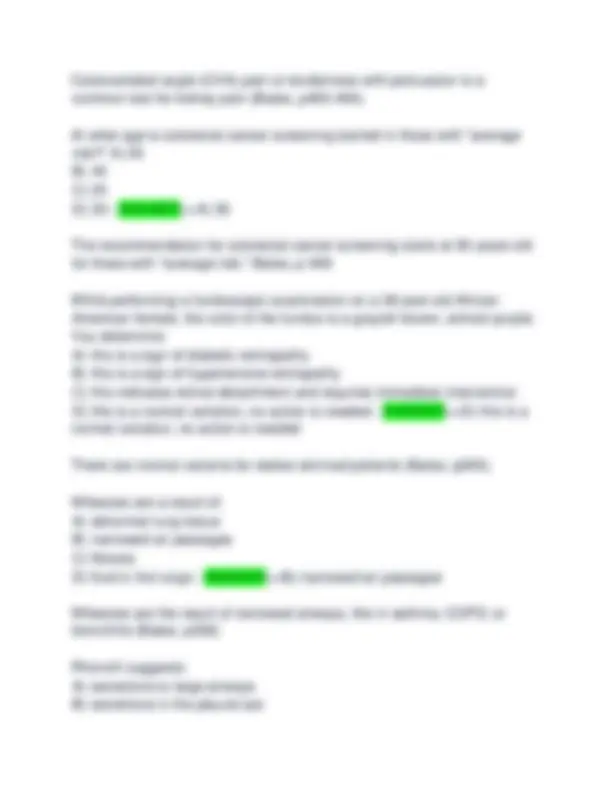
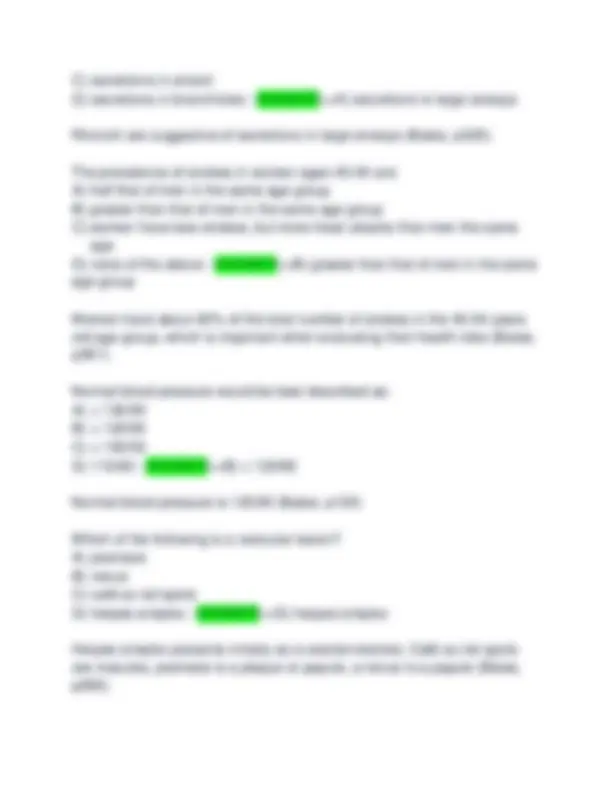
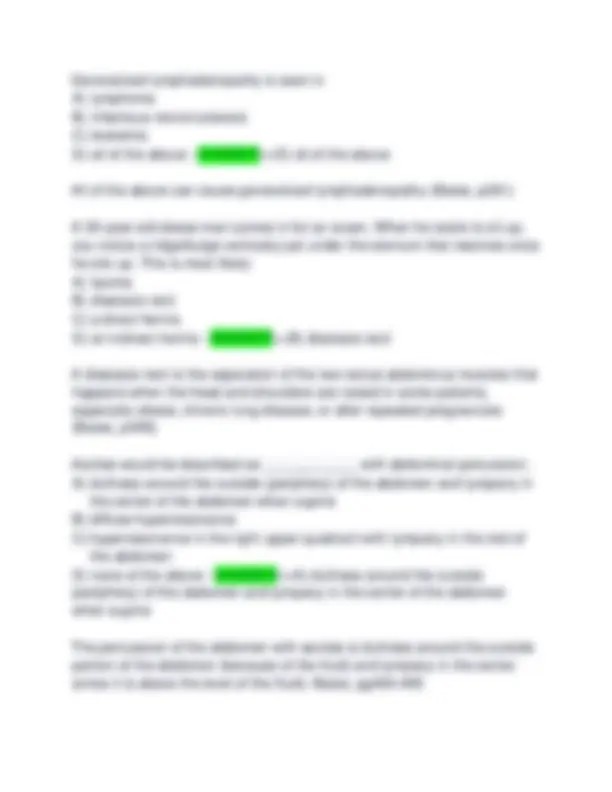
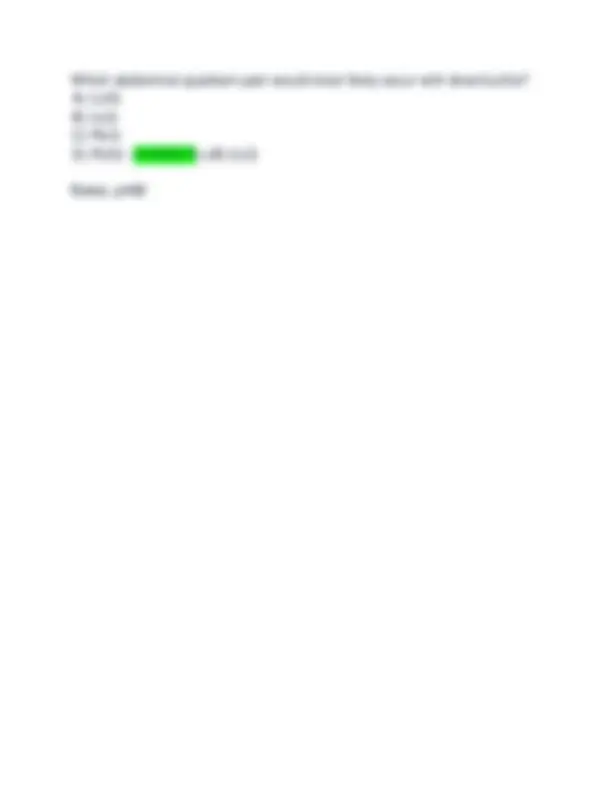


Study with the several resources on Docsity

Earn points by helping other students or get them with a premium plan


Prepare for your exams
Study with the several resources on Docsity

Earn points to download
Earn points by helping other students or get them with a premium plan
Community
Ask the community for help and clear up your study doubts
Discover the best universities in your country according to Docsity users
Free resources
Download our free guides on studying techniques, anxiety management strategies, and thesis advice from Docsity tutors
Advanced Health Assessment Questions With Correct Answers. 2024-25 LATEST UPDATE GRADED A+ A 59 year old patients tells the nurse practitioner that he thinks he must have ulcerative colitis. He has been having "black stools" for the last 24 hours. How would the nurse practitioner best document THE FACTS for his reason for seeking care? A) JM is a 59 year old male here for having "black stools" for the past 24 hours. B) JM came into the clinic complaining of black stools for the past 24 hours. C) JM is a 59 year old male here for "ulcerative colitis." D) JM, a 59 year old male, states he has ulcerative colitis and wants it checked. - ANSWER >>A) JM is a 59 year old male here for having "black stools" for the past 24 hours.
Typology: Exams
1 / 37

This page cannot be seen from the preview
Don't miss anything!






























A 59 year old patients tells the nurse practitioner that he thinks he must have ulcerative colitis. He has been having "black stools" for the last 24 hours. How would the nurse practitioner best document THE FACTS for his reason for seeking care? A) JM is a 59 year old male here for having "black stools" for the past 24 hours. B) JM came into the clinic complaining of black stools for the past 24 hours. C) JM is a 59 year old male here for "ulcerative colitis." D) JM, a 59 year old male, states he has ulcerative colitis and wants it checked. - ANSWER>>A) JM is a 59 year old male here for having "black stools" for the past 24 hours. Chief Complaint(s) The one or more symptoms or concerns causing the patient to seek care. Make every effort to quote the patient's own words. A patient tells the nurse practitioner that she has had abdominal pain for the past week. What would be the best response by the nurse practitioner? A) We'll talk more about that later in the interview." B) "Have you ever had any children?" C) "What have you had to eat in the last 4 hours?" D) "Can you point to where it hurts?" - ANSWER>>D) "Can you point to where it hurts?" Each principle symptom should be well-characterized, with descriptions of location; along with the other seven attributes. Location: Ask the patient to point to the pain because lay terms may not be specific enough to localize the site of origin.
A 29-year-old woman tells the nurse that she has "excruciating pain" in her back. Which of the following would be an appropriate response by the nurse to her statement? A) "How does your family react to your pain?" B) "That must be terrible. You probably pinched a nerve." C) "I've had back pain myself and it can be excruciating." D) "How would you say the pain affects your ability to do your daily activities?" - ANSWER>>D) "How would you say the pain affects your ability to do your daily activities?" Inquire about the effects of pain on the patient's daily activities, mood, sleep, work, and sexual activity. In recording the childhood illnesses of a patient who denies having had any, which of the following notes by the nurse would be most accurate? A) Patient denies usual childhood illnesses. B) Patient states he was a "very healthy" child. C) Patient states sister had measles, but he didn't. D) Patient denies measles, mumps, rubella, chickenpox, pertussis, rheumatic fever, and polio. - ANSWER>>D) Patient denies measles, mumps, rubella, chickenpox, pertussis, rheumatic fever, and polio. Childhood illnesses include measles, rubella, mumps, whooping cough, rheumatic fever, scarlet fever, and polio. They are included in the past history. A patient tells the nurse that he is allergic to penicillin. What would be the nurse's best response to this information? A) "Are you allergic to any other drugs?" B) "How often have you received penicillin?" C) "I'll write your allergy on your chart so you won't receive any." D) "Please describe what happens to you when you take penicillin." - ANSWER>>D) "Please describe what happens to you when you take penicillin."
Remember that the history (from the chief complaint through review of systems) should be limited to patient statements or subjective data— factors that the person says were or were not present. Subjective data is what the patient tells you. The following information is best placed in which category? "The patient had a stent placed in the left anterior descending artery (LAD) in 1999." A) Medical B) Surgical C) Obstetrics/gynecology D) Psychiatric - ANSWER>>B) Surgical Provide information relative to Adult Illnesses in each of four areas: Medical, Surgical, Obstetric/Gynecologic, and Psychiatric. During the aging process, the hair can look gray or white and begin to feel thin and fine. The nurse practitioner knows that this occurs because of a decrease in: A) pigmentation B) thyroid stimulating hormone C) phagocytes D) fungacytes - ANSWER>>A) pigmentation Hair undergoes a series of changes. Scalp hair loses its pigment (functioning of melanocytes) so the hair looks gray or white and feels thin and fine. The other options are not correct. You are speaking to an 8th grade class about health prevention and are preparing to discuss the ABCDEs of melanoma. Which of the following descriptions correctly defines the ABCDEs? A) A = actinic; B = basal cell; C = color changes, especially blue; D = diameter >6 mm; E = evolution B) A = asymmetry; B = irregular borders; C = color changes, especially blue; D = diameter >6 mm; E = evolution C) A = actinic; B = irregular borders; C = keratoses; D = dystrophic nails; E = evolution
D) A = asymmetry; B = regular borders; C = color changes, especially orange; D = diameter >6 mm; E = evolution - ANSWER>>B) A = asymmetry; B = irregular borders; C = color changes, especially blue; D = diameter >6 mm; E = evolution You are examining the skin on a 22 year old female when you notice a circumscribed superficial lesion that is elevated approximately 0.5cm in diameter, filled with serous fluid. What type of lesion is this? A) macule B) papule C) vesicle D) spider angioma - ANSWER>>C) vesicle Vesicle - up to 1.0 cm filled with serous fluid A 72-year-old teacher comes to a skilled nursing facility for rehabilitation after being in the hospital for 6 weeks. She was treated for sepsis and respiratory failure and had to be on a ventilator for 3 weeks. The nurse is completing an initial assessment and evaluating the client's skin condition. On her sacrum there is full-thickness skin loss that is 5 cm in diameter with damage to the subcutaneous tissue. The underlying muscle is not affected. What is the stage of this pressure ulcer? A) Stage 1 B) Stage 2 C) Stage 3 D) Stage 4 - ANSWER>>C) Stage 3 A crater appears in the skin, with full-thickness skin loss and damage to or necrosis of subcutaneous tissue that may extend to, but not through underlying muscle. Mrs. Anderson presents with an itchy rash which is raised and appears and disappears in various locations. Each lesion lasts for many minutes. What most likely accounts for this rash? A) Insect bites
C) Psoriasis D) Tinea infection - ANSWER>>C) Psoriasis Psoriasis: silvery scaly papules or plaques, mainly on the extensor surfaces. Pitting: punctate depressions of the nail plate caused by defective layering of the superficial nail plate by the proximal nail matrix. Usually associated with psoriasis. Suzanne, a 25 year old, comes to your clinic to establish care. You are the student preparing to go into the examination room to interview her. Which of the following is the most logical sequence for the patient-provider interview? A) Establish the agenda, negotiate a plan, establish rapport, and invite the patient's story. B) Invite the patient's story, negotiate a plan, establish the agenda, and establish rapport. C) Greet the patient, establish rapport, invite the patient's story, establish the agenda, expand and clarify the patient's story, and negotiate a plan. D) Negotiate a plan, establish an agenda, invite the patient's story, and establish rapport. - ANSWER>>C) Greet the patient, establish rapport, invite the patient's story, establish the agenda, expand and clarify the patient's story, and negotiate a plan. The sequence of the interview: Greeting the patient and establishing rapport. Taking notes. Establishing the agenda for the interview. Inviting the patient's story. Expanding and clarifying the patient's story. Sharing the treatment plan. A young woman undergoes cranial nerve testing. On touching the soft palate, her uvula deviates to the left. Which of the following is likely? A) CN IX lesion on the left B) CN X lesion on the left C) CN IX lesion on the right D) CN X lesion on the right - ANSWER>>D) CN X lesion on the right
In cranial nerve X paralysis, the soft palate fails to rise and the uvula deviates to the opposite side. When performing posterior palpation of the thyroid gland, you should do all fo the following, EXCEPT: A) Have the patient tip his or her head forward and slightly to the side. B) Place your index fingers above the cricoid cartilage. C) Palpate between the sternocleidomastoid muscle and the trachea for the lobes of the thyroid. D) Move your fingers laterally to palpate for the thyroid lobes. - ANSWER>>B) Place your index fingers above the cricoid cartilage. Place the fingers of both hands on the patient's neck so that your index fingers are just BELOW the cricoid cartilage. You are interviewing an elderly woman in the ambulatory setting and trying to get more information about her urinary symptoms. Which of the following techniques is NOT a component of guided questioning? A) Reassuring the patient that the urinary symptoms are benign and that she doesn't need to worry about it being a sign of cancer. B) Offering the patient multiple choices in order to clarify the character of the urinary symptoms she is experiencing. C) Asking her to tell you what she means when she states that she has a urinary tract infection. D) Directed questioning starting with the general and proceeding to the specific in a manner that does not make the patient give a yes/no ANSWER. - ANSWER>>A) Reassuring the patient that the urinary symptoms are benign and that she doesn't need to worry about it being a sign of cancer. Bates p 59, 69- 71 Mrs. T. comes for her regular visit to the clinic. She is on your schedule because her regular provider is on vacation and she wanted to be seen.
flexibility in the order of the examination, and caring but firm approach are all key to successfully examining the young child. A patient has come in for an examination and states, "I have this spot in front of my ear lobe here on my cheek that seems to be getting bigger and is tender. What do you think it is?" The NP notes swelling above the angle of the jaw and suspects it could be an inflammation of his: A) occipital node B) thyroid gland C) parotid gland D) none of the above - ANSWER>>C) parotid gland The swelling of the parotid gland is seen anterior to the ear lobes and above the angles of the jaw. All of the following are a common or concerning symptom in a health history for a respiratory assessment EXCEPT? A) palpitations B) blood-streaked sputum C) chest pain D) snoring - ANSWER>>A) palpitations Chest pain, blood-streaked sputum, and snoring are all common or concerning symptoms in a health history for respiratory assessment. A 29-year-old physical therapist presents for evaluation of an eyelid problem. On observation, the right eyeball appears to be protruding forward. Based on this description, what is the most likely diagnosis? A) Epicanthus B) Ptosis C) Exophthalmos D) Ectropion - ANSWER>>C) Exophthalmos Eye protrusion (proptosis or exophthalmos)
The nurse practitioner is performing an eye examination using the ophthalmoscope. Which component is NOT part of the ophthalmoscope? A) lens disc B) aperature C) indicator of diopters D) speculum - ANSWER>>D) speculum See picture of ophthalmoscope (Bates p 238) A 15-year-old high school sophomore presents to the emergency room with his mother for evaluation of an area of blood in the left eye. He denies trauma or injury but has been coughing forcefully with a recent cold. He denies visual disturbances, eye pain, or discharge from the eye. On physical examination, the pupils are equal, round, and reactive to light, with a visual acuity of 20/20 in each eye and 20/20 bilaterally. There is a homogeneous, sharply demarcated area at the lateral aspect of the base of the left eye. The cornea is clear. Based on this description, what is the most likely diagnosis? A) Conjunctivitis B) Acute iritis C) Corneal abrasion D) Subconjunctival hemorrhage - ANSWER>>D) Subconjunctival hemorrhage Leakage of blood outside of the vessels, producing a homogenous, sharply demarcated, red area. The pupil is not affected, vision is not affected and the cornea is clear. May result from trauma, bleeding disorders, or sudden increase in venous pressure, as from a cough. The nurse practitioner is reviewing for a class in age-related changes in the eye. Which of these physiological changes is responsible for presbyopia? A) degeneration of the cornea B) decreased adaptation to darkness C) decreased distance vision abilities D) loss of lens elasticity - ANSWER>>D) loss of lens elasticity
Which of the following enables optimal examination of the adult's tympanic membrane? A) Grasp the auricle firmly and pull it downward, backward, and pressed close to the head. B) Grasp the auricle firmly but gently and pull it upward, backward, and slightly away from the head. C) Pull the ear lobe toward the chin and keep the auricle pulled away from the head. D) Grasp the auricle keeping it in normal position and pressed close to the head. - ANSWER>>B) Grasp the auricle firmly but gently and pull it upward, backward, and slightly away from the head. To straighten the ear canal, grasp the auricle firmly but gently and pull it upward, backward, and slightly away from the head (Bates, p 245). In using the ophthalmoscope to assess a patient's eyes, the nurse notices a red glow in the patient's pupils. On the basis of this finding, the nurse would: A) check the light source of the ophthalmoscope to verify that it is functioning. B) consider this a normal reflection of the ophthalmoscope light off the inner retina. C) continue with the ophthalmoscopic examination and refer the patient for further evaluation. D) suspect that there is an opacity in the lens or cornea. - ANSWER>>B) consider this a normal reflection of the ophthalmoscope light off the inner retina. Shine the light beam on the pupil and look for the orange glow in the pupil - the red reflex. (Bates, p239). The other responses are not correct. A 15 month old is brought to you for a fever of 101 F and fussiness. The ear examination is as follows: external ear - normal appearance and no tenderness with manipulation; canal - normal diameter without evidence of
inflammation; tympanic membrane - bulging, erythematous, and the light reflex is dull. Insufflation is deferred due to pain. What is your diagnosis? A) ruptured tympanic membrane B) cholesteatoma C) otitis media D) otitis externa - ANSWER>>C) otitis media Acute otitis media in a symptomatic child typically has a red, bulging tympanic membrane, with a dull or absent light reflex. The nurse practitioner is assessing a patient who may have hearing loss. Which of these statements is true concerning air conduction? A) Air conduction is the normal pathway for hearing. B) Vibrations of the bones in the skull cause air conduction. C) Amplitude of sound determines the pitch that is heard. D) Loss of air conduction is called a conductive hearing loss. - ANSWER>>A) Air conduction is the normal pathway for hearing. The normal pathway of hearing is air conduction, which starts when sound waves produce vibrations on the tympanic membrane. Conductive hearing loss results from a mechanical dysfunction of the external or middle ear. The other statements are not true concerning air conduction. When examining the ear of a young child, which of the following is the proper technique to use? A) Examine the ear canal and tympanic membrane as the last steps in the exam if the child is sensitive or fearful. B) Pull the auricle downward, outward, and backward for the best view. C) Use the largest speculum possible on the otoscope. D) All of the above. - ANSWER>>D) All of the above. If a child is fearful or sensitive because she can't see the ear exam, you might need to restrain her so wait until the end of the exam. Use the largest speculum for the best view. For best visualization, pull the auricle downward, outward, and backward (Bates 867-869).
C) The appearance of the membrane is identical to that of an adult. D) The normal membrane may appear thick and opaque because of the vernix caseosa obscuring the tympanic membrane for the first few days of life. - ANSWER>>D) The normal membrane may appear thick and opaque because of the vernix caseosa obscuring the tympanic membrane for the first few days of life. During the first few days, the tympanic membrane often looks thickened and opaque because there is vernix caseosa obscuring the tympanic membrane (Bates, p825). The projections in the nasal cavity that increase the surface area are called the: A) Kiesselbach plexus B) turbinates C) meatus D) septum - ANSWER>>B) turbinates The lateral walls of each nasal cavity contain 3 parallel bony projections: the superior, middle, and inferior turbinates. They increase the surface area so that more blood vessels and mucous membrane are available to warm, humidify, and filter the inhaled air (Bates, p250). All of the following are true of the nasal inspection EXCEPT: A) Tilt the patient's head back a bit and insert the speculum gently into the vestibule of each nostril. Avoid contact with the nasal septum. You should inspect the inferior and middle turbinates, the nasal septum, and the narrow passage between them. B) In viral rhinitis, the mucosa is usually reddened and swollen, and in allergic rhinitis the mucosa is often pale, bluish, or red. C) Examine the inside of the nose without a speculum on the otoscope keeping the otoscope 6-10 inches away from the tip of the patient's nose are you look at each nostril. D) Use the largest available ear speculum on the otoscope during
inspection. - ANSWER>>C) Examine the inside of the nose without a speculum on the otoscope keeping the otoscope 6-10 inches away from the tip of the patient's nose are you look at each nostril. Tilt the patient's head back a bit and insert the speculum gently into the vestibule of each nostril. Avoid contact with the nasal septum. Use the largest available speculum. In viral rhinitis, the mucosa is usually reddened and swollen, and in allergic rhinitis the mucosa is often pale, bluish, or red. A 46 year old female patient is in the clinic with a chief complaint of chest pain. You are wanting to best understand the patient's perception of the chest pain. Which fo the following questions would you ask first? A) How do you rate your pain on a scale of 0-10? B) Is the pain related to exertion? C) Tell me about your chest discomfort. D) Are you taking all of your medications? - ANSWER>>C) Tell me about your chest discomfort. Move from open ended to focused questions to allow for the flow of ideas and thoughts from the patient. The nurse practitioner is doing an assessment on a 21 year old patient and notices that his nasal mucosa appears pale and bluish. What would be the most appropriate question to ask the patient? A) Have you had any symptoms of a cold? B) Don't ask any questions. This is a normal finding. C) Are you aware of having any allergies? D) Have you been having frequent nosebleeds? - ANSWER>>C) Are you aware of having any allergies? With chronic allergy, mucosa looks swollen, boggy, pale, and gray. Colds and nosebleeds do not cause these mucosal changes.
C) resonant to hyper-resonant sounds with percussion and wheezes present D) diffusely hyper-resonant sounds with percussion, decreased or absent breath sounds per auscultation, decreased tactile fremitus, and no crackles, wheezes, or rhonchi. - ANSWER>>D) diffusely hyper-resonant sounds with percussion, decreased or absent breath sounds per auscultation, decreased tactile fremitus, and no crackles, wheezes, or rhonchi. COPD is characterized by diffusely hyper-resonant sounds with percussion, decreased or absent breath sounds per auscultation, decreased tactile fremitus, and no crackles, wheezes, or rhonchi. (Bates, p340) Which of the following is true about auscultating the heart? A) the diaphragm is better for picking up the sounds of S1 and S2 and the bell is better for picking up the sounds of S3 and S4. B) The bell is better for picking up the sounds of S1 and S2 and the diaphragm is better for picking up the sounds of S3 and S4. C) The diaphragm is not necessary for accurate auscultation during the cardiac exam. D) The bell is not necessary for the cardiac exam, but it is necessary for accurate auscultation during the abdominal exam. - ANSWER>>A) the diaphragm is better for picking up the sounds of S1 and S2 and the bell is better for picking up the sounds of S3 and S4. (Bates, p390) The nurse practitioner aucultates the heart and hears a murmur which she documents as 4/6 at its loudest point. She means the murmur is: A) moderately loud B) very loud, with thrill. May be heard when the stethoscope is partly off the chest. C) loud with a palpable thrill. D) quiet, but heard immediately after placing the stethoscope on the chest.
Physiologic splitting of the S2 in the 2nd and 3rd interspace, which is usually accentuated by inspiration, is caused by: A) the closing of the aortic and pulmonic valves B) the addition of the S4 sound C) the addition of the S3 sound D) the closing of the tricuspid and mitral valves - ANSWER>>A) the closing of the aortic and pulmonic valves Physiologic splitting of the S2 = closing of the aortic and pulmonic valves. Usually, the pulmonic valve closure is too faint to be heart but at the apex. The split is accentuated upon inspiration and disappears on expiration (Bates, p405). When assessing a patient's lungs, the nurse recalls that the left lung: A) is shorter than the right lung because of the underlying stomach. B) is divided by the horizontal fissure. C) consists of 2 lobes. D) consists primarily of an upper lobe on the posterior chest. - ANSWER>>C) consists of 2 lobes. The left lung has 2 lobes, and the right lung has 3 lobes. The right lung is shorter than the left lung because of the underlying LIVER. The left lung is narrower than the right lung because the heart bulges to the left. The posterior chest is almost all lower lobe (Bates, p307). The primary muscles of respiration include the : A) trapezius and rectus abdominis. B) sternomastoids and scaleni. C) diaphragm and intercostals. D) external obliques and pectoralis major. - ANSWER>>C) diaphragm and intercostals. The major muscle of respiration is the diaphragm. The intercostal muscles life the sternum and elevate the ribs during inspiration, increasing the